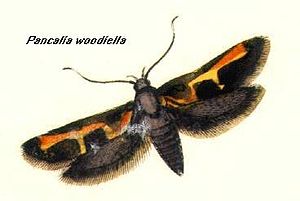Antequerinae
| Antequerinae | ||||||||||
|---|---|---|---|---|---|---|---|---|---|---|

Illustration of Euclemensia woodiella |
||||||||||
| Systematics | ||||||||||
|
||||||||||
| Scientific name | ||||||||||
| Antequerinae | ||||||||||
| Hodges , 1978 |
The Antequerinae are a subfamily of the magnificent butterflies (Cosmopterigidae). It comprises eight species in four genera that are common in North America and England.
features
In females, the frenulum has three bristles (acanthi). The retinaculum usually consists of a series of forward-facing scales between the wing veins CuA and R. This is also the termination of the cell of the hind wings, which is at a 45 ° angle from the vein M2 to the base of the wing. The aedeagus is free, the valves consist of a single flap, the costal or saccular margins are neither developed nor differentiated.
The caterpillars have a subventral bristle on the first abdominal segment, the bristle SD1 is bristly formed on the ninth abdominal segment. The chitin claws of the abdominal legs are arranged in a uniordinal circle. The dolls are unknown.
Way of life and systematics
The caterpillars of the genus Euclemensia are parasitoids of scale insects . The following genera are assigned to the Antequerinae by Kristensen:
- Antequera Clarke, 1941
- Euclemensia Grote, 1878
- Pancalia Stephens, 1829
- Ramphis Riedl, 1969
supporting documents
Individual evidence
- ↑ a b c d Niels P. Kristensen: Lepidoptera, moths and butterflies . In: Maximilian Fischer (Ed.): Handbook of Zoology . 1st edition. tape 4 - Arthropoda: Insecta , volume 35. de Gruyter, Berlin / New York 1998, ISBN 3-11-015704-7 (English).
literature
- Niels P. Kristensen: Lepidoptera, moths and butterflies . In: Maximilian Fischer (Ed.): Handbook of Zoology . 1st edition. tape 4 - Arthropoda: Insecta , volume 35. de Gruyter, Berlin / New York 1998, ISBN 3-11-015704-7 (English).
- Malcolm J. Scoble: The Lepidoptera: Form, Function and Diversity . Oxford University Press, Oxford 1995, ISBN 0-19-854952-0 (English).